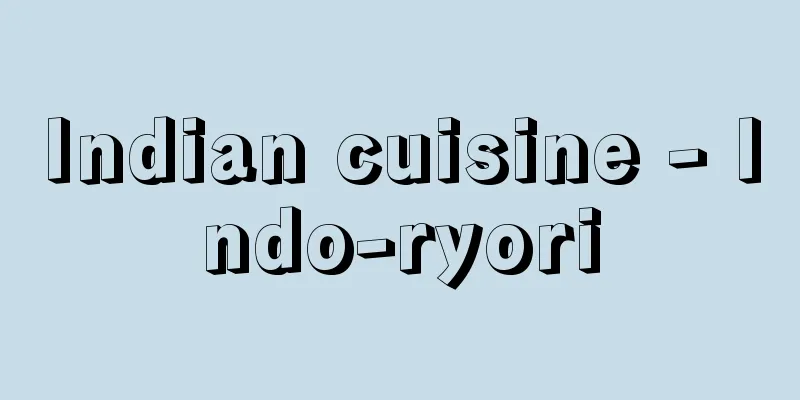Indian cuisine - Indo-ryori

|
The cuisine of the vast Indian subcontinent, which has a land area nine times that of Japan and a population eight times that of the country, is difficult to summarize due to the diversity of races, languages, religions and customs. The food taboos of the Hindus, who make up 75% of the population, and the Muslims, who live mainly in the north, are completely different. There has been a vertical axis of change, as the country has been constantly influenced by the invasions of powerful countries, from the invasion of the Aryan tribes to British rule, and there are also large horizontal differences in climate and geography, such as Kashmir in the north and Cape Comorin in the south, and Kolkata (Calcutta) in the east and Mumbai (Bombay) in the west. As most of the country is agricultural, and the population is growing year by year, issues of food production and weather are of concern to the people, and there is a very strong connection between food and festivals. If we were to summarize the characteristics of Indian cuisine, we would mention the use of spices as the main seasoning, known as curry dishes, the development of dairy products such as ghee, which is an essential cooking oil, and the use of dried pulses collectively known as dal. In terms of eating habits, they are very careful about purity and impurity, so always bring food to their mouths with their right hand, use disposable banana leaves as plates or only personal thalis and small metal bowls, and serve food all at once without courses. One extreme difference between the two countries is that while Muslims consume large amounts of mutton and beef, and use them as main ingredients in curry (pork is taboo), there are many Hindus, especially those of higher social classes, who are vegetarian and maintain the custom of not eating beef, let alone chicken or eggs. For protein, they rely solely on beans and dairy products. As in China and Italy, India is divided into a flour-based diet, mainly consisting of wheat, in the north and a rice-based diet in the east and south. In other words, in the north, bread called roti is the staple food, followed by naan, chapati, paratha, poori, etc. In the south, rice is eaten as white rice with soupy dishes, but in the north there are rice dishes called pulao and biryani, which are clearly influenced by the Middle East. Pulao is made in the same way as pilaf, but with an abundance of raisins, nuts and spices, while biryani is even more luxurious with more ingredients. Tandoori chicken is a dish loved by people all over the world. Chicken marinated overnight in yogurt and spices is roasted whole in a jar-shaped earthen oven called a tandoor. If tandoori chicken is the king of Indian cuisine, then its queen is kholma, made by marinating meat in yogurt to remove the unpleasant odor, then simmering it in a rich mixture of spices. Its rich and complex flavor, which rivals that of French stews, is also a popular choice at luxury hotels that attract foreigners. Naturally, seafood dishes are well developed in port cities such as Mumbai and Goa, and in the eastern Bengal region, but perhaps in proportion to the hot climate, many of the dishes are hot to the mouth, and chili peppers are used frequently. Those who are not used to it can even upset their stomachs. Vindaloo is particularly famous in the south, where hot spices are crushed with vinegar to make a paste, and meat or fish is marinated in this and then boiled. Ingredients vary from region to region, but Indian cuisine includes kofta, meat and vegetable dumplings, paneer, cottage cheese dumplings, dosa, a crepe-like thin bread wrapped around various foods, and samosa, a fried dish made from thin wheat flour dough wrapped around spiced lamb or potato. Many bean dishes are inseparable from the meals of ordinary people, including sambar, the Japanese equivalent of miso soup, and papar, a rice cracker-like snack. Buttermilk lassi and raita, a yogurt salad, provide a moment of refreshment to a mouth numbed by the spiciness of chili and pepper. Sweet confections are garnished with very thin gold or silver leaf or flower petals to add a touch of elegance. [Blue Sea Rooster] [References] | | | | | |Source: Shogakukan Encyclopedia Nipponica About Encyclopedia Nipponica Information | Legend |
|
日本の9倍の国土、8倍強の人口をもつ広大なインド亜大陸の料理は、人種、言語、宗教、風俗の多様さのゆえに要約することはむずかしい。75%を占めるヒンドゥー教徒と、北部を中心とするイスラム教徒では食事のタブーもまったく異なる。アーリア民族の侵入に始まり、イギリスの統治に至るまで、絶えず強国の侵略の影響を受けてきた縦軸の変化と、北のカシミールと南のコモリン岬、東のコルカタ(カルカッタ)と西のムンバイ(ボンベイ)というような、気候風土の横軸の差も大きい。国土の大部分が農業地域で、しかも年々増え続ける人口を抱えるので、食糧生産と天候の問題が人々の関心事であり、食べ物と祭事の縁も非常に深い。 しいてインド料理の特徴をまとめれば、まず香辛料を調味の主役とした、いわゆるカレー料理、食用油として欠かせないギーをはじめとする乳製品の発達、ダールと総称される乾燥豆類の利用があげられよう。 また、食習慣のうえからは、浄・不浄を気にしてすべて右手で食物を口に運び、使い捨てのバナナの葉を皿がわりにするか、あるいは個人用のターリ(盆)と金属の小鉢ぐらいしか使わないこと、料理にコースがなく一度に出してしまうこと、などがあげられる。同じ国でありながら極端に違っている点は、イスラム教徒が羊肉、牛肉を多量に消費し、カレーの主材料としても用いながら(豚肉はタブー)、これに対しヒンドゥー教徒のとくに階層の高いものほど菜食主義者が多く、牛肉どころか鶏や卵も食べない習慣が守られていることである。タンパク質は豆と乳製品のみに頼っている。 中国やイタリアにみられるように、インドも北部は小麦を中心とする粉食、東・南部は米食と分かれる。つまり、北部ではローティとよばれるパン類が主食で、ナーン、チャパティ、パラーター、プーリーなどがある。米は、南部では白いご飯として、汁けの多い料理をかけて食べるが、北部には明らかに中東の影響を受けたとみられるプラオとビリヤーニーという炊きこみ御飯がある。プラオはピラフと同じ作り方だが、レーズンやナッツ類とスパイスを豊富に使い、ビリヤーニーはさらに具の量が多く豪華になる。 世界の人々に愛される料理としてはタンドーリチキンがあげられる。ヨーグルトとスパイスに一晩漬けた鶏をまるのまま、タンドールという壺(つぼ)形の土かまどで焼き上げる。タンドーリチキンをインド料理の王者とすれば、女王とよばれるのは、同じくヨーグルトに漬けて臭みを抜いた肉を、スパイスを豊富に使って煮込んだコールマーである。フランスの煮込み料理に劣らぬこくのある複雑な味は、外国人の集まる高級ホテルでも人気の的となっている。 ムンバイやゴアなどの港湾都市、あるいは東側のベンガル地方には当然のことながら魚貝料理が発達しているが、暑い気候に比例してか、いわゆる口に熱く感じる料理が多く、トウガラシも多用される。慣れない者が食べると胃腸を壊すこともあるくらいである。南部でとくに名高いのがビンダルーで、辛味のきいたスパイスを酢とともにつぶしてペースト状にし、これに肉や魚を漬け込んでから煮たものである。 地域によって材料は異なるが、肉や野菜を団子にしたコーフター、カテージチーズを団子にしたパニール、クレープ風の薄焼きでいろいろなものを包んで食べるドーサ、小麦粉を練って薄くのした皮に、香辛料で味つけしたラム肉やジャガイモを包んで揚げるサモサなど、インドならではの味である。豆料理では、日本のみそ汁に相当するサンバル、煎餅(せんべい)のようなパパルをはじめ、庶民の食事とは切っても切れないものが多い。バターミルクのラッシー、ヨーグルトサラダのライタなどは、トウガラシやコショウの辛味でしびれた口に、ひとときの清涼感を与えてくれる。甘い菓子には、ごく薄い金箔(きんぱく)、銀箔や花びらが添えられて華やかさを盛り上げている。 [碧海酉癸] [参照項目] | | | | | |出典 小学館 日本大百科全書(ニッポニカ)日本大百科全書(ニッポニカ)について 情報 | 凡例 |
>>: Indri - Indori (English spelling) indri
Recommend
Gaucho Plains - Gaucho Plains
…It is located on the south shore of Lake Patos a...
Red squill
...Today, it is subject to the Poisonous and Dele...
ethnic
(Noun) (adjective verb) (ethnic) Something that is...
Eight-colored surnames - Yakusa no kabane
Also called "Hashiki no sei" or "Ha...
Coelostat - Coelostat (English spelling)
A device that always sends light from the sun and...
Relative price - relative price
The price that expresses the value relationship of...
Mountain sheep
…Also called bighorn sheep, it is a sheep with la...
Kita no Oheya
...Even in such a case, it is still shameful. As ...
Nobu Shirase
Antarctic explorer, Army Quartermaster Lieutenant...
Alta (dance) - Alta
…Though the origins of dance in Spain are very ol...
American chestnut
...It is difficult to cultivate in Japan because ...
Shadow Blue - Inchin
It is a type of white porcelain, also called blue...
Bamberger, L.
...Located in Princeton, New Jersey, it has close...
vesnyanki
...Kolyadka is a song that accompanies a rite of ...
Karinite - Karinite
...It has a specific gravity of 1.97, is highly s...









